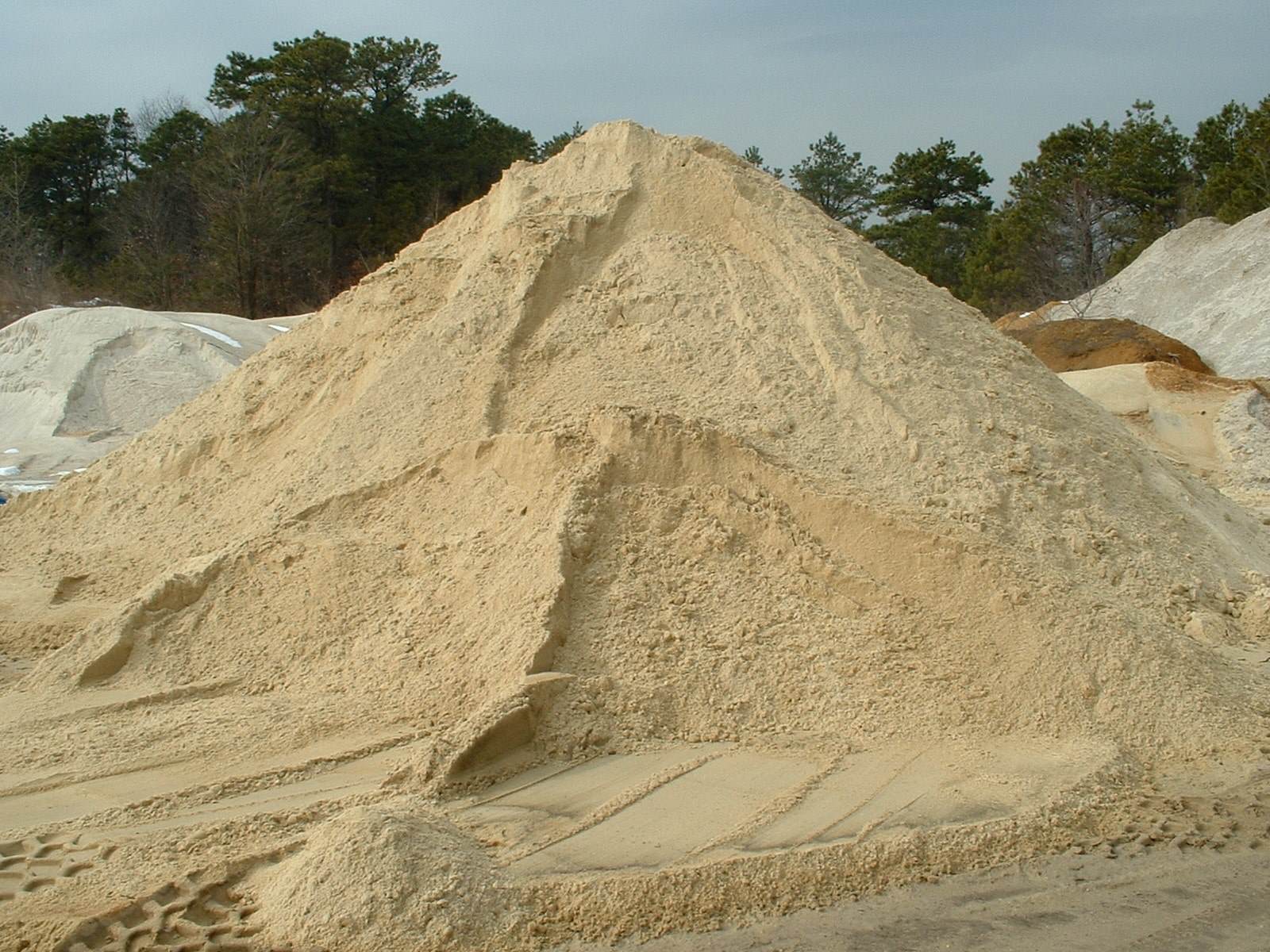

Science
The Surprising Weight Of A Cubic Yard Of Sand!
Published: February 10, 2024
Discover the science behind the surprising weight of a cubic yard of sand and how it impacts various applications. Explore the fascinating properties of sand in this insightful article!
(Many of the links in this article redirect to a specific reviewed product. Your purchase of these products through affiliate links helps to generate commission for Regretless.com, at no extra cost. Learn more)
Table of Contents
Introduction
Sand, a ubiquitous substance found in various forms across the globe, holds a surprising characteristic that often goes unnoticed: its weight. While sand is commonly associated with lightness and ease of movement, the actual weight of a cubic yard of sand may astonish many. In this article, we delve into the composition of sand, explore the factors influencing its weight, and uncover its diverse applications in the realms of construction, landscaping, and beyond.
Sand, a granular material primarily composed of finely divided rock and mineral particles, is a vital component in numerous human activities and natural processes. From the picturesque shores of beaches to the construction sites where sturdy foundations are built, the significance of sand cannot be overstated. It serves as the fundamental building block for various man-made structures, including concrete, asphalt, and mortar, and plays a pivotal role in the creation of glass, ceramics, and electronics. Moreover, the natural movement of sand shapes landscapes, influences ecosystems, and contributes to the formation of geological formations over time.
Despite its seemingly lightweight and delicate nature, the weight of sand is a matter of substantial interest and importance, especially in industries where precise measurements and calculations are crucial. The weight of a cubic yard of sand can vary significantly based on several factors, such as its composition, moisture content, and particle size distribution. Understanding these factors is essential for engineers, architects, and construction professionals to accurately estimate the quantity of sand required for specific projects and to ensure the structural integrity and stability of their creations.
As we embark on this exploration of the surprising weight of a cubic yard of sand, we will unravel the intricate characteristics of this seemingly simple substance and gain a deeper appreciation for its role in shaping the world around us. Let's delve into the fascinating world of sand and uncover the hidden weight that lies beneath its tranquil appearance.
The Composition of Sand
Sand, a naturally occurring granular material, is primarily composed of finely divided rock and mineral particles. The most common type of sand is derived from the erosion and weathering of rocks, with the specific composition varying based on the geological sources and environmental conditions. The main constituents of sand include silicon dioxide (SiO2) in the form of quartz, along with other minerals such as feldspar, mica, and various types of rock fragments.
Quartz, a crystalline form of silicon dioxide, is a predominant component of many types of sand due to its abundance in the Earth's crust. This mineral imparts distinctive properties to the sand, including high hardness, resistance to chemical weathering, and the ability to withstand high temperatures. These characteristics make quartz-rich sand particularly valuable in industrial applications such as glass manufacturing, foundry casting, and abrasives production.
In addition to quartz, sand may contain varying proportions of feldspar, a group of minerals that contribute to the color and texture of the material. Feldspar-rich sands often exhibit a diverse range of colors, including shades of pink, red, and white, adding aesthetic appeal to landscaping and decorative purposes.
Furthermore, the presence of mica, a group of silicate minerals known for their excellent cleavage and lustrous appearance, can influence the texture and cohesiveness of sand. Sands with higher mica content may display a slightly glittery or reflective quality, making them sought after for artistic and ornamental applications.
The composition of sand can also include fragments of different types of rocks, such as granite, limestone, and basalt, which contribute to the overall diversity and texture of the material. These rock fragments, along with organic particles and mineral grains, collectively form the intricate matrix of sand, showcasing the geological history and environmental processes that have shaped its formation over time.
In summary, the composition of sand is a complex amalgamation of minerals, rock fragments, and organic matter, each contributing to its unique characteristics and suitability for a wide range of practical and aesthetic uses. Understanding the diverse composition of sand provides valuable insights into its physical properties, chemical behavior, and the potential applications across various industries and natural environments.
The Weight of Sand
The weight of sand, a seemingly unassuming material, holds significant implications for a wide array of industries and applications. When considering the weight of sand, it is essential to recognize that this characteristic can vary based on multiple factors, including the specific composition of the sand, its moisture content, and the size distribution of its particles.
On average, a cubic yard of dry sand can weigh between 2,600 to 3,000 pounds. However, this weight range is not absolute and can fluctuate based on the aforementioned factors. The presence of moisture in sand can notably impact its weight, as the water content adds mass to the material. Therefore, damp or wet sand will weigh more than dry sand due to the additional weight of the water absorbed within its granular structure.
Furthermore, the particle size distribution within the sand can influence its weight. Finer sands, composed of smaller particles, tend to be denser and thus heavier than coarser sands with larger particles. This variation in particle size directly impacts the overall weight of a given volume of sand, making it crucial to consider the specific characteristics of the sand in question when estimating its weight for practical purposes.
In construction and engineering, the weight of sand plays a critical role in determining the load-bearing capacity of foundations, backfill materials, and structural elements. Engineers and builders rely on accurate weight calculations to ensure the stability and integrity of structures, making precise measurements of sand weight essential for the successful completion of construction projects.
Moreover, understanding the weight of sand is vital for transportation and logistical purposes. Whether it is for landscaping, road construction, or industrial processes, knowing the weight of sand enables efficient planning and management of material handling, storage, and distribution.
In summary, the weight of sand is a multifaceted aspect that goes beyond its outward appearance. It is a fundamental consideration for a myriad of practical and industrial applications, influencing the design, construction, and utilization of various structures and products. By comprehending the factors affecting the weight of sand, professionals across diverse fields can make informed decisions and precise calculations, ultimately contributing to the safety, efficiency, and sustainability of their endeavors.
Factors Affecting the Weight of Sand
The weight of sand, a seemingly straightforward characteristic, is influenced by several key factors that significantly impact its overall mass and density. Understanding these factors is crucial for accurately estimating the weight of sand in various practical and industrial contexts.
1. Moisture Content:
The presence of moisture in sand has a substantial effect on its weight. Dry sand, devoid of moisture, exhibits a lower weight compared to wet or damp sand. When sand absorbs water, its mass increases due to the added weight of the water held within the interstitial spaces between the granules. As a result, wet sand can weigh significantly more than dry sand, making precise moisture content measurements essential for accurate weight calculations.
Read more: How To Calculate Cubic Inches
2. Particle Size Distribution:
The size distribution of sand particles plays a pivotal role in determining its weight. Finer sands, composed of smaller particles, tend to be denser and heavier than coarser sands with larger particles. This difference in density arises from the packing arrangement of the particles, where smaller grains can fill void spaces more effectively, resulting in a higher overall mass per unit volume. Therefore, the particle size distribution directly influences the weight of a given volume of sand, necessitating consideration when estimating material quantities for specific applications.
3. Composition and Mineralogy:
The mineral composition of sand, particularly the presence of heavy minerals and dense rock fragments, can contribute to variations in its weight. Sands rich in denser minerals, such as magnetite or hematite, will exhibit higher overall weights compared to sands predominantly composed of lighter minerals like quartz. Additionally, the inclusion of organic matter, clay particles, or other lightweight components can influence the density and weight of the sand, highlighting the diverse nature of sand compositions and their corresponding weight characteristics.
4. Compaction and Porosity:
The degree of compaction and porosity within a sand deposit can affect its weight. Well-compacted sands with minimal porosity tend to be denser and heavier, as the granular particles are tightly packed, leaving fewer void spaces. In contrast, loosely packed or porous sands may have lower overall weights due to the presence of larger voids and reduced particle density. Understanding the compaction and porosity of sand is essential for engineering and construction applications, as it directly impacts load-bearing capacities and stability.
In summary, the weight of sand is intricately influenced by its moisture content, particle size distribution, composition, and compaction characteristics. By considering these factors, professionals in fields ranging from construction and engineering to material science and geology can make informed decisions regarding the utilization, transportation, and management of sand, ultimately contributing to the efficient and sustainable implementation of sand-based projects and processes.
Applications of Sand
Sand, with its versatile properties and wide availability, finds extensive applications across diverse industries and natural settings. From construction and manufacturing to environmental and artistic endeavors, the utilization of sand spans a broad spectrum, showcasing its indispensable role in shaping the world around us.
1. Construction and Infrastructure:
Sand serves as a foundational material in construction, playing a crucial role in the production of concrete, mortar, and asphalt. Its use as a key component in these essential building materials underpins the construction of roads, bridges, buildings, and various infrastructure projects. Additionally, sand is utilized as a bedding material for pipes, cables, and utility lines, providing stability and support for underground installations.
2. Landscaping and Beautification:
In landscaping and beautification efforts, sand is employed for creating aesthetically pleasing features such as beaches, sand dunes, and decorative pathways. Its use in ornamental designs, zen gardens, and outdoor recreational spaces adds a touch of natural elegance while offering practical benefits such as soil drainage and erosion control.
3. Glass Manufacturing:
The production of glass heavily relies on high-quality silica sand, which serves as the primary raw material. The unique chemical and physical properties of silica sand make it indispensable for creating a wide range of glass products, including bottles, windows, fiberglass, and specialty glassware.
4. Foundry and Casting:
Sand casting, a widely utilized metal casting process, involves the use of sand molds to create intricate metal components and products. The mold-making properties of sand, combined with its ability to withstand high temperatures, make it an ideal material for shaping and casting various metal alloys in foundry operations.
5. Filtration and Water Treatment:
In water treatment and filtration systems, sand is employed as a filter medium to remove impurities and particles from water. Its natural porosity and uniform particle size distribution enable effective filtration, making it a vital component in municipal water treatment plants, swimming pool filters, and industrial filtration processes.
6. Abrasives and Surface Finishing:
Coarse sand and fine sand particles are utilized as abrasives for surface finishing, polishing, and cleaning applications. Sandblasting, a technique that uses high-pressure sand particles to remove surface contaminants and impart texture to materials, is widely employed in industrial, automotive, and artistic contexts.
7. Environmental and Geological Processes:
In natural environments, sand plays a pivotal role in shaping landscapes, supporting ecosystems, and influencing geological formations. Its presence in riverbeds, coastal areas, and deserts contributes to the dynamic processes of erosion, sediment transport, and the formation of distinctive landforms.
8. Sports and Recreation:
Sand is synonymous with recreational activities such as beach volleyball, sandcastle building, and beach sports. Its soft and malleable nature makes it an ideal medium for creating leisure spaces and outdoor recreational facilities, fostering a sense of enjoyment and relaxation for individuals of all ages.
In essence, the applications of sand encompass a wide array of practical, industrial, and natural domains, reflecting its inherent versatility and significance in numerous aspects of human activity and environmental processes. The diverse uses of sand underscore its enduring importance as a fundamental material that contributes to the functionality, aesthetics, and sustainability of our built environment and natural landscapes.
Conclusion
In conclusion, the weight of a cubic yard of sand encompasses a complex interplay of factors, including moisture content, particle size distribution, and mineral composition, all of which contribute to its surprising weight variability. This seemingly unassuming material, with its diverse applications and essential role in construction, manufacturing, and natural processes, holds far-reaching implications that extend beyond its tranquil appearance.
By unraveling the composition of sand, we gain a deeper understanding of its intricate matrix of minerals, rock fragments, and organic matter, showcasing the geological history and environmental processes that have shaped its formation over time. The presence of quartz, feldspar, mica, and various rock fragments within sand highlights its diverse and visually captivating nature, underscoring its suitability for practical and aesthetic uses across a multitude of industries and natural settings.
The weight of sand, influenced by its moisture content, particle size distribution, and mineral composition, serves as a critical consideration for engineers, builders, and professionals across diverse fields. Accurate weight calculations are indispensable for ensuring the stability and integrity of structures, efficient material transportation and management, and the successful implementation of sand-based projects and processes.
Furthermore, the versatile applications of sand, spanning construction, glass manufacturing, filtration, foundry casting, landscaping, and recreational pursuits, underscore its indispensable role in shaping the world around us. From the creation of iconic architectural marvels to the formation of picturesque natural landscapes, sand stands as a foundational material that contributes to the functionality, aesthetics, and sustainability of our built environment and natural ecosystems.
In essence, the weight of sand, with its surprising intricacies and diverse applications, serves as a testament to the profound impact of seemingly ordinary materials on the fabric of our world. As we continue to explore and harness the potential of sand in innovative and sustainable ways, we further recognize its enduring significance as a fundamental component that shapes our surroundings and enriches our lives.











